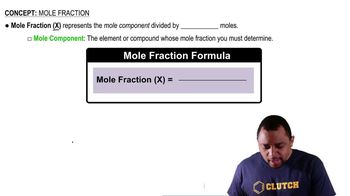Which solution has the highest vapor pressure? a. 20.0 g of glucose (C6H12O6) in 100.0 mL of water b. 20.0 g of sucrose (C12H22O11) in 100.0 mL of water c. 10.0 g of potassium acetate KC2H3O2 in 100.0 mL of water
Ch.13 - Solutions
Chapter 13, Problem 71
Calculate the vapor pressure of a solution containing 24.5 g of glycerin (C3H8O3) in 135 mL of water at 30.0 °C. The vapor pressure of pure water at this temperature is 31.8 torr. Assume that glycerin is not volatile and dissolves molecularly (i.e., it is not ionic), and use a density of 1.00 g/mL for the water.
 Verified step by step guidance
Verified step by step guidance1
Calculate the number of moles of glycerin (C3H8O3) using its molar mass. The molar mass of glycerin is calculated by adding the atomic masses of its constituent atoms: 3 carbons (C), 8 hydrogens (H), and 3 oxygens (O).
Determine the mass of water in grams using the given density and volume. Since the density of water is given as 1.00 g/mL, multiply the volume of water (135 mL) by the density to find the mass in grams.
Calculate the number of moles of water using its molar mass. The molar mass of water (H2O) is the sum of the atomic masses of 2 hydrogens and 1 oxygen.
Use Raoult's Law to find the vapor pressure of the solution. Raoult's Law states that the vapor pressure of a solution is equal to the mole fraction of the solvent times the vapor pressure of the pure solvent. Calculate the mole fraction of water by dividing the moles of water by the total moles of the solution (moles of water + moles of glycerin).
Multiply the mole fraction of water by the vapor pressure of pure water at 30.0 °C to find the vapor pressure of the solution.

Verified video answer for a similar problem:
This video solution was recommended by our tutors as helpful for the problem above.
Video duration:
4mWas this helpful?
Key Concepts
Here are the essential concepts you must grasp in order to answer the question correctly.
Vapor Pressure
Vapor pressure is the pressure exerted by a vapor in equilibrium with its liquid or solid form at a given temperature. It reflects the tendency of particles to escape from the liquid phase into the vapor phase. In solutions, the presence of a non-volatile solute, like glycerin, lowers the vapor pressure of the solvent compared to its pure state.
Recommended video:
Guided course

Raoult's Law and Vapor Pressure
Raoult's Law
Raoult's Law states that the vapor pressure of a solvent in a solution is directly proportional to the mole fraction of the solvent. This law is crucial for calculating the vapor pressure of a solution when a non-volatile solute is present. It helps determine how the addition of solute affects the overall vapor pressure of the solvent.
Recommended video:
Guided course

Raoult's Law and Vapor Pressure
Mole Fraction
Mole fraction is a way of expressing the concentration of a component in a mixture, defined as the number of moles of that component divided by the total number of moles of all components. In this context, calculating the mole fraction of water in the solution is essential for applying Raoult's Law to find the new vapor pressure after glycerin is added.
Recommended video:
Guided course

Mole Fraction Formula
Related Practice
Textbook Question
Textbook Question
A solution contains 50.0 g of heptane (C7H16) and 50.0 g of octane (C8H18) at 25 °C. The vapor pressures of pure heptane and pure octane at 25 °C are 45.8 torr and 10.9 torr, respectively. Assuming ideal behavior, answer the following: d. Why is the composition of the vapor different from the composition of the solution?
Textbook Question
A solution contains a mixture of pentane and hexane at room temperature. The solution has a vapor pressure of 258 torr. Pure pentane and hexane have vapor pressures of 425 torr and 151 torr, respectively, at room temperature. What is the mole fraction composition of the mixture? (Assume ideal behavior.)
